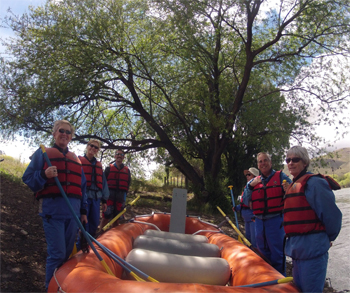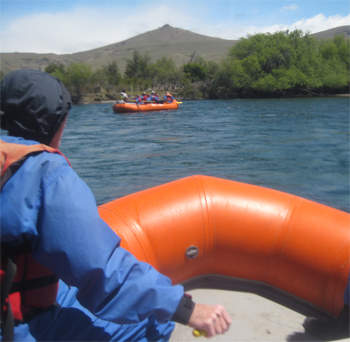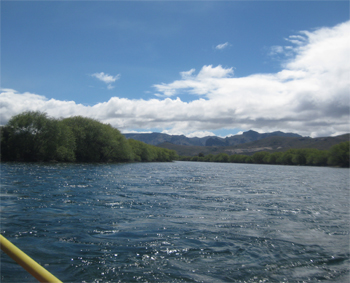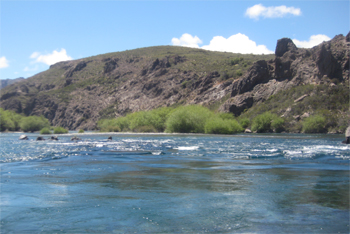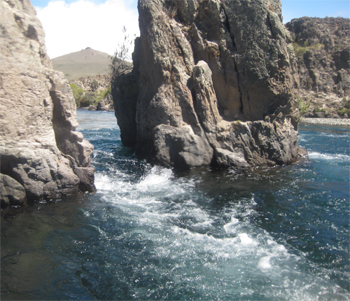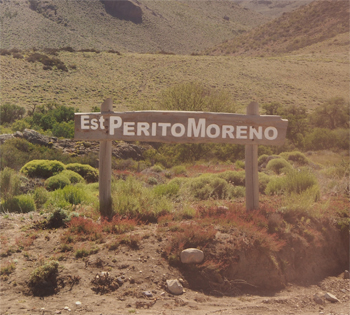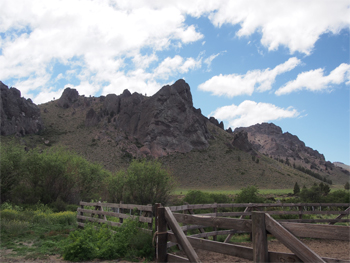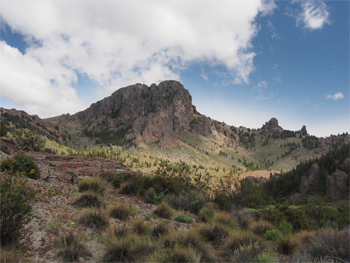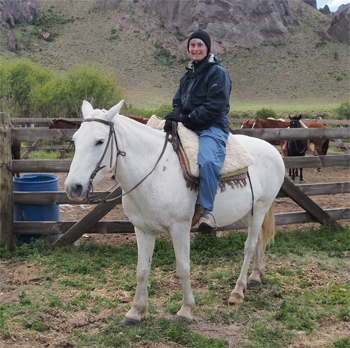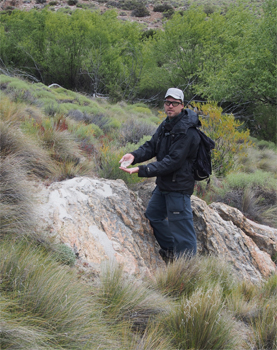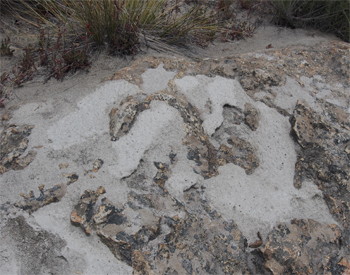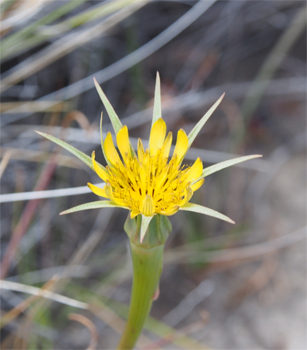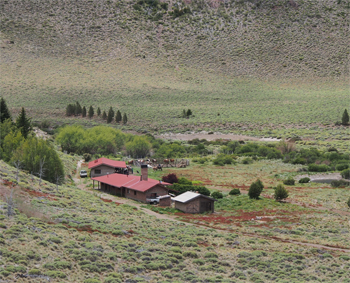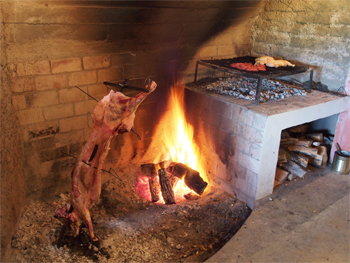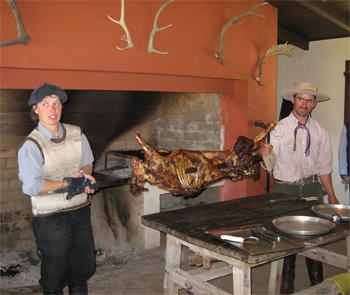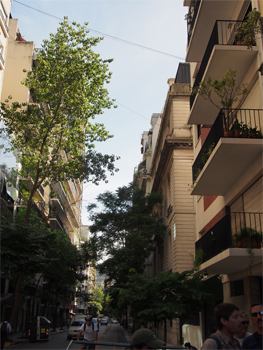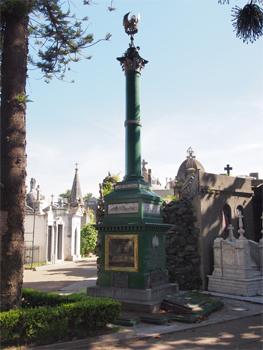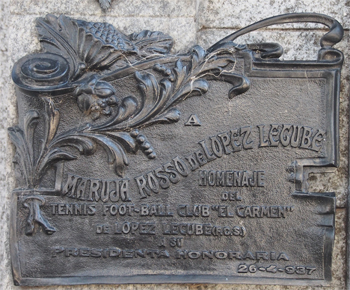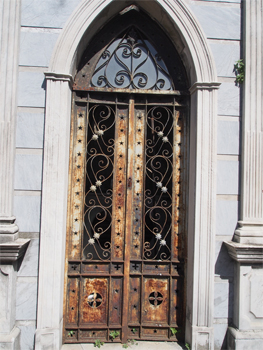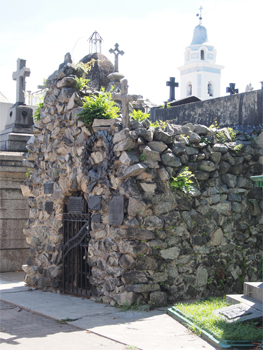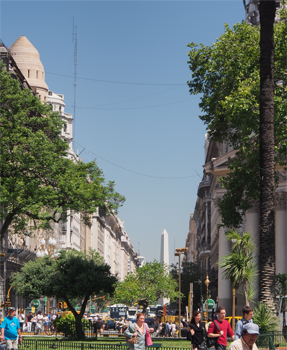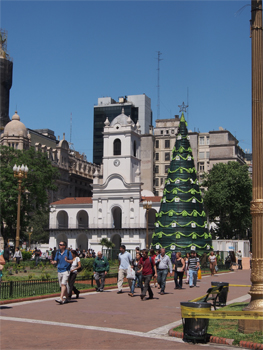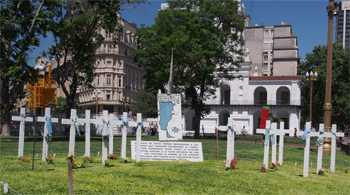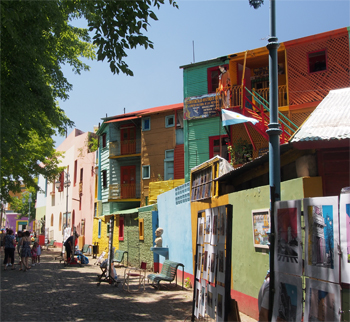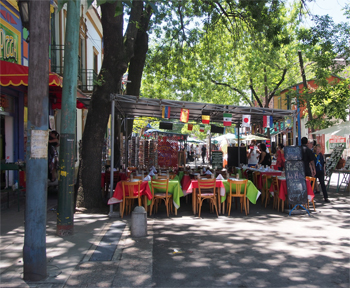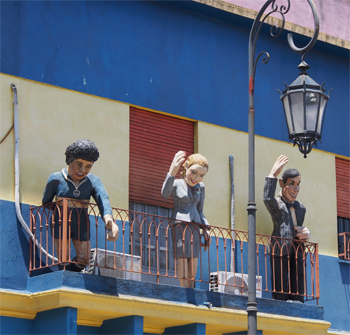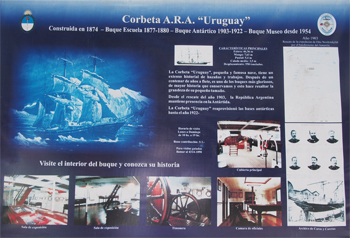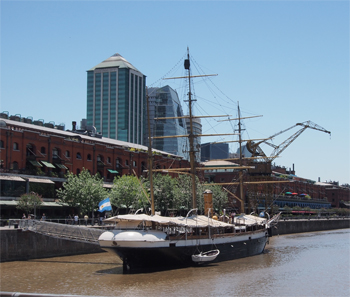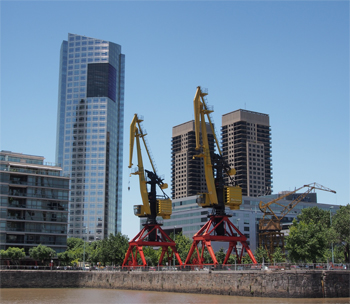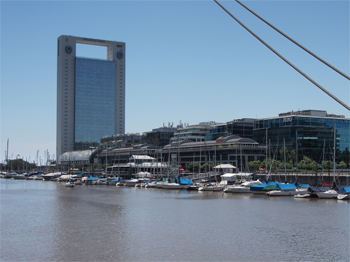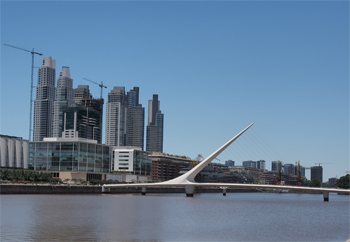Tues., 12/18/12 - Bariloche
Today we were supposed to go rafting on the Rio Mancos with class II and III rapids. However, it was supposed to be cold an rainy in the mountains so Fede substituted a float down a placid stretch of the Rio Limay which is out on the steppes. The river really didn't even have a class I rapid. It was pretty, but boring and certainly not worth the $125. for the optional tour.
Lunch was at a restaurant where we pulled out. They cooked chorizo, blood sausage, chicken thighs and legs, and some unidentifiable cut of beef on an open grill/fireplace and served it with cold boiled potatoes, lettuce and tomato salad, and bread. The meat was not desirable. We had Neapolitan ice cream for dessert.
Rio Limay raft float - preparing the boats |
Ready to go float
|
Rio Limay raft float - the crew |
Rio Limay raft float
|
Rio Limay raft float - A ripple!
|
Rio Limay raft float - at least the countryside was pretty |
Rio Limay raft float - rapid class 0.25 |
Rio Limay raft float - we didn't go through here
|
Rio Limay raft float - almost a class I
|
PS - We didn't even get wet!
|
This morning we visited the 75,000-acre San Moreno Ranch, or estancia, a working sheep and cattle ranch on the Patagonian Steppe. The estancia is currently owned by a Swiss person, who visits twice a year and who is a benevolent owner. She provides homes for the workers who manage 10,000 merino sheep and 1,000 beef cattle. She also sends the children by bus to a private school. We later learned that many sheep died in 2011 because of the ash from the Chilean volcano (Puyehue) that covered the ground here. The ash became like cement in the sheep's stomachs and they died. The cattle were trucked to another ranch that was free from the ash.
The host and ranch manager greeted us with a Patagonian variety of fry bread with a berry jam and a cup of tea. Yummy! Five of us took a horseback ride and the others took a guided trek to see the beautiful rock formations and landscape (grassland) on the steppe.
Estancia Perito Moreno
|
Estancia Perito Moreno - surroundings |
Estancia Perito Moreno - surroundings |
Gale all ready to ride
|
Fede showing residue of the ash from the June 2011 erruption of Puyehue volcano in Chile
|
Residue of the ash from the June 2011 erruption of Puyehue volcano in Chile |
Wildflowers
|
Yellow Salsify |
Estancia Perito Moreno - main buildings
|
Back at the ranch we ate lunch in what was once the schoolroom. They skewered a side of lamb, killed yesterday, and grilled it in a huge fireplace. We had empanadas, homemade chorizo, as much lamb as we could eat, and the usual tomato and lettuce salad. Dessert was a nice bowl of fruit. Of course there was the red or white wine. We were hungry and the food was good.
|
Estancia Perito Moreno - lunch roasting |
Lunch - ready to eat
|
Back at the hotel we attended a lecture about the native Mapuche people. They have lived in the area for at least 2,000 years but were treated like our North American Indians and native people in so many other countries. Our speaker, Christina, spoke and Fede translated about their life. She became a social activist while at the university and is a main force in reestablishing pride in the native Mapuche people. Their biggest aim is to recover their original land but they have to fight corporations like Benetton and Fisher Toys who have bought huge areas of land, displaced the native sheep farmers and, since the natives have no deeds to the land, they cannot prevent the rich from taking over.
At 7:30 we decided to put on our rain suits and walk into town to shop for a souvenir spoon and chocolates. We picked Mamuschka to buy some dinner delights because they had dark chocolate filled with Amarula liquor. We first tasted Amarula in South Africa and really like it. We also bought a Bariloche spoon for my collection.
Thurs., 12/20/12 - Bariloche to Buenos Aires
We flew Lan Air back to Buenos Aire, met the other 14 members of our tour group, (only 12 of us went on the pre-trip to Patagonia), and went off to another "Welcome" dinner, this time at the Cabana Villegas Restaurant. Dinner was very good - empanadas, sirloin steak, salad, fries, and flan with one free glass of wine. We got back to the hotel at 11PM.
Fri., 12/21/12 - The day the world will end on the Mayan calendar - Buenos Aires
After breakfast at the hotel we departed for our tour of "Buenos Aires Highlights." This began with an eight-block walk around the neighborhood where Fede stopped a man pulling a cart filled with recyclable material and discarded meat from a local butchery. The man explained that he has lived in one room in a shantytown with his wife and five kids for 8 years. The meat will feed them for a month, if the government does not shut off their jury-rigged electricity. His kids go to school so the family gets some government support. We were glad to give him tips for this on the spot "learning and discovery."
We boarded our bus for the short drive to the Recoleta district and to the Recoleta Cemetery, where the rich and famous are buried. The cemetery is really a mass of 4,691 mausoleums (vaults) of which 94 have been declared National Historical Monuments by the Argentine government. We walked down several of the wide lanes, observing many different styles of mausoleums, and saw where Eva Peron is buried. She died in 1952, at age 33, of uterine cancer. There is a love-hate conflict in Argentina about Eva. She did many good things for the lower class like medical clinics, schools, universities, factory worker vacations, improved work conditions, etc. The rich, of course, complained that they were paying for all of this. One quote explains some of this: "Eva gave the people fish instead of teaching them to fish."
Next we got on our bus and went to the Plaza de Mayo, at one end of which is the Pink Palace. Plaza de Mayo is a place where many protests and demonstrations take place. The Pink House is the presidential offices and not a residence.
Street scene
|
Recoleta Cemetery |
Recoleta Cemetery
|
Recoleta Cemetery - many different kinds of tombs or mausoleums |
Recoleta Cemetery - a sportsman |
Recoleta Cemetery - tomb of Eva Peron
|
Recoleta Cemetery |
|
Plaza de Mayo - Obelisk in the distance |
Plaza de Mayo - Cabildo museum and Christmas tree in the plaza - it was about 95 degrees
|
Plaza de Mayo - protest signs - Malvinas or Falklands
|
Plaza de Mayo - protest signs |
Casa Rosada (Pink Palace) - government executive offices
|
Free time to walk around the La Boca district was next. Many immigrants who worked at the docks built the corrugated metal abodes. They are painted in bright or pastel colors and now include tourist shops, cafes, and flea markets. There are several caricature statues around the area. On the balcony of one were a famous soccer player (Maradona), Eva Peron, and a famous Tango singer and composer (Astor Piazzolia). Many of the cafes had couples performing tango to entice you to sit, eat, and be entertained.
|
La Boca barrio
|
La Boca barrio |
Maradona (soccer player), Eva Peron, and Astor Piazzolia (tango singer and composer)
|
The last stop on our tour was at the Old Port - Puerto Madero. We took a quick tour of the barque or frigate, Corbeta (corvette) A R A. Uruguay. It was a battleship that was refitted to go to Antarctica to successfully rescue a Swiss expedition team that was stranded there for two years.
|
"Uruguay" sign |
Corbeta A.R.A. Uruguay
|
Buildings and cranes
|
Riverfront |
Women's Bridge (Puente de la Mujer)
|
We rode back to the hotel and then walked four blocks to a wonderful Argentina pizza restaurant, El Cuartito, for a late lunch. It was 3:30 PM and the place was crammed with patrons and a line out the door waiting for take away. A nice waiter seated us and got us our pizza and a stout beer and then our "cuenta" (the check) without having to wait on Latin time.
|


